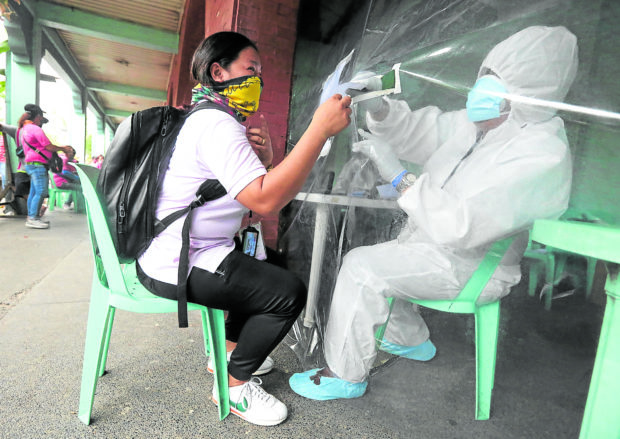WHO reminds Pinoys: No rapid drop yet in virus cases; stay home

SUDDEN SPIKE Pasay City Hall employees get the results of their rapid tests for the new coronavirus on Tuesday as 305 new infections are reported by the Department of Health without an explanation, leaving the public uninformed on the cause of the sudden spike in cases. —MARIANNE BERMUDEZ
MANILA, Philippines — Even if restrictions on movement are eased in the coming days, the World Health Organization (WHO) advised Filipinos on Tuesday to still stay at home, especially as the Philippines has not seen coronavirus cases “rapidly decrease” in the nearly three-month implementation of strict quarantine measures.
Dr. Takeshi Nishijima, WHO Western Pacific technical officer, said it is important for Filipinos to still observe health measures, such as staying at home and physical distancing, given that there is the potential for new cases to rise.
“It is very important to stay at home for the public to prevent the further spread of the infection. The number of newly recorded cases is not rapidly decreasing even after the strict implementation of the community quarantine,” Nishijima said at the Department of Health’s (DOH) virtual press briefing.
Stabilizing
“In the Philippines, we are seeing the number of new cases kind of stabilize. We are hoping it will decrease in the future. For that, I think we need to be prepared to continue what we [are doing] right now,” he added.
On Tuesday, the DOH reported 350 new coronavirus cases, bringing the national tally to 14,669.
Article continues after this advertisementThis is the first time in nearly three weeks that new cases for the day exceeded more than 300. On May 7, there were 339 new cases.
Article continues after this advertisementThe total number of recoveries increased to 3,412 with the recovery of 89 more patients. The death toll, however, rose to 886 as 13 patients succumbed to the severe respiratory disease.
For most of the month, new cases averaged at 220. The DOH did not provide an explanation why there has been a spike in new cases on Tuesday nor did it give a breakdown of where most of the cases were recorded.
But since the outbreak began in March, Metro Manila accounted for the majority of the cases.
Quarantine measures may be relaxed some more in the metropolis by June.
Minimum health standards
On Tuesday, the DOH found itself clarifying again the statement of Health Secretary Francisco Duque III after it appeared that he contradicted President Duterte’s statement that he will not allow students to go back to school until a vaccine for COVID-19 is available.
Health Undersecretary Maria Rosario Vergeire maintained that there is no policy difference between the President and Duque when the health chief said in a Senate hearing that it will be “safe” to reopen classes in August, especially if the minimum health standards set by his agency were met and observed.
“[His statement] is not contradictory. Secretary Duque said that if we are able to follow the minimum health standards … we can be more assured of our students’ safety. If we are able to do this and the result of our assessment is that it is safe for our schools to open then we can open classes,” Vergeire said in her online press briefing.
“But if we are unable to ensure the safety of our schools because we do not observe the minimum health standards, like what the President said, we will not open our schools until there is a vaccine against the virus,” she added.
Among the minimum health standards are physical distancing, having supplies for hand hygiene, disinfecting tables, placing foot baths in the entrances and providing personal protective equipment.
This is not the first time the DOH had to elaborate what its chief meant.
Last week, Duque drew flak after he told senators that the country was actually experiencing a second wave of infections.
Epidemiologist John Wong explained that the first wave occurred in January with the three Chinese tourists who tested positive for the virus. He noted, though, that the current cases are part of the “first major wave” of infections.
Under fire
Since the start of the outbreak, Duque has been under fire for the government’s inadequate response in curbing the spread of the virus.
Several quarters have already called for his resignation for his supposed “inability to lead the country’s pandemic response as it’s top health official.”
Meanwhile, there are now 2,420 health-care workers who have been infected with SARS-CoV-2, the new coronavirus that causes COVID-19. Of these, 1,163 have recovered while 31 have died. Vergeire noted, though, that since May 10, the DOH has not recorded any COVID-19-related deaths among medical front-liners.
As for the DOH’s emergency hiring program, Vergeire said that a total 2,607 health-care workers had been so far hired and deployed in 202 hospitals and quarantines across the country.